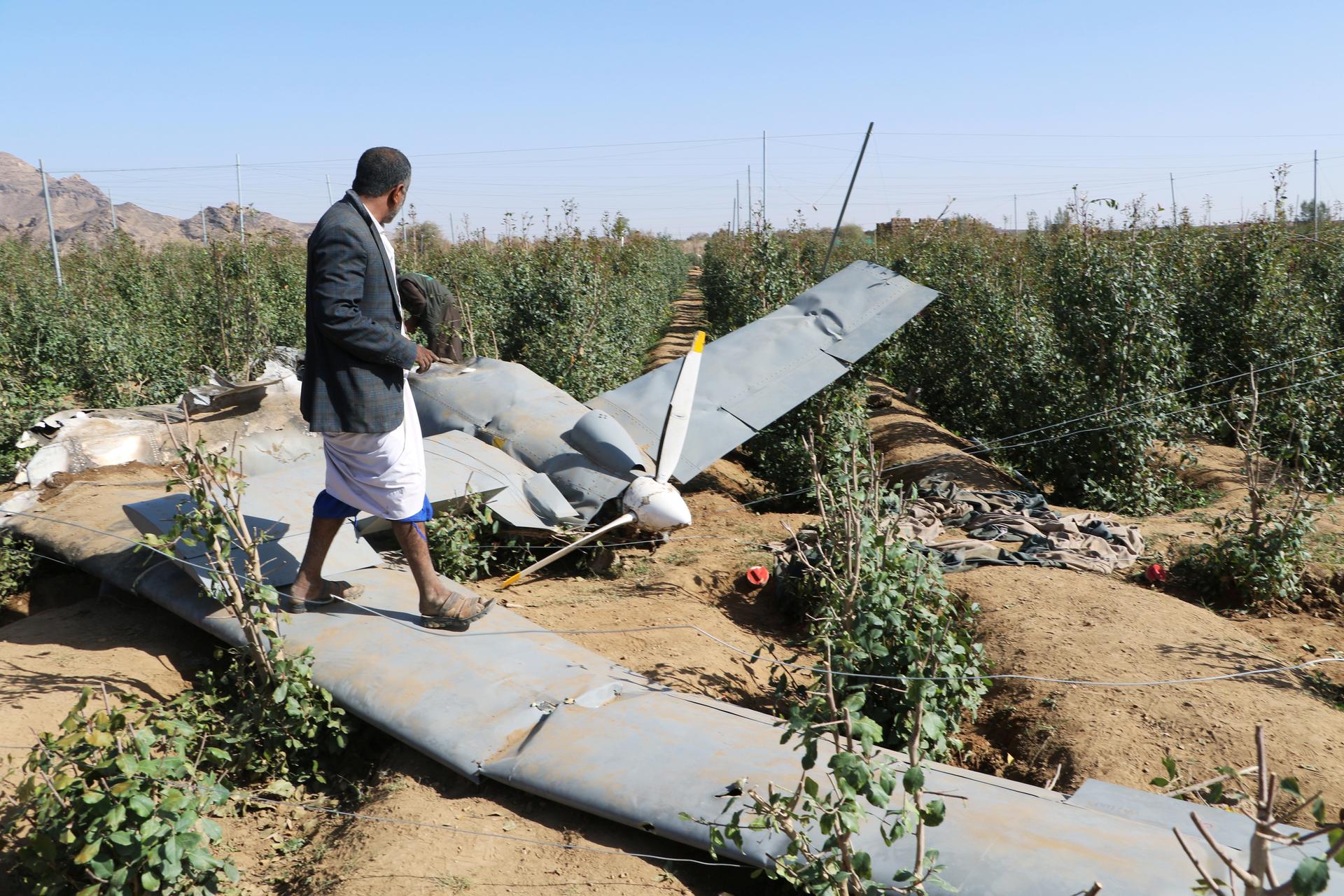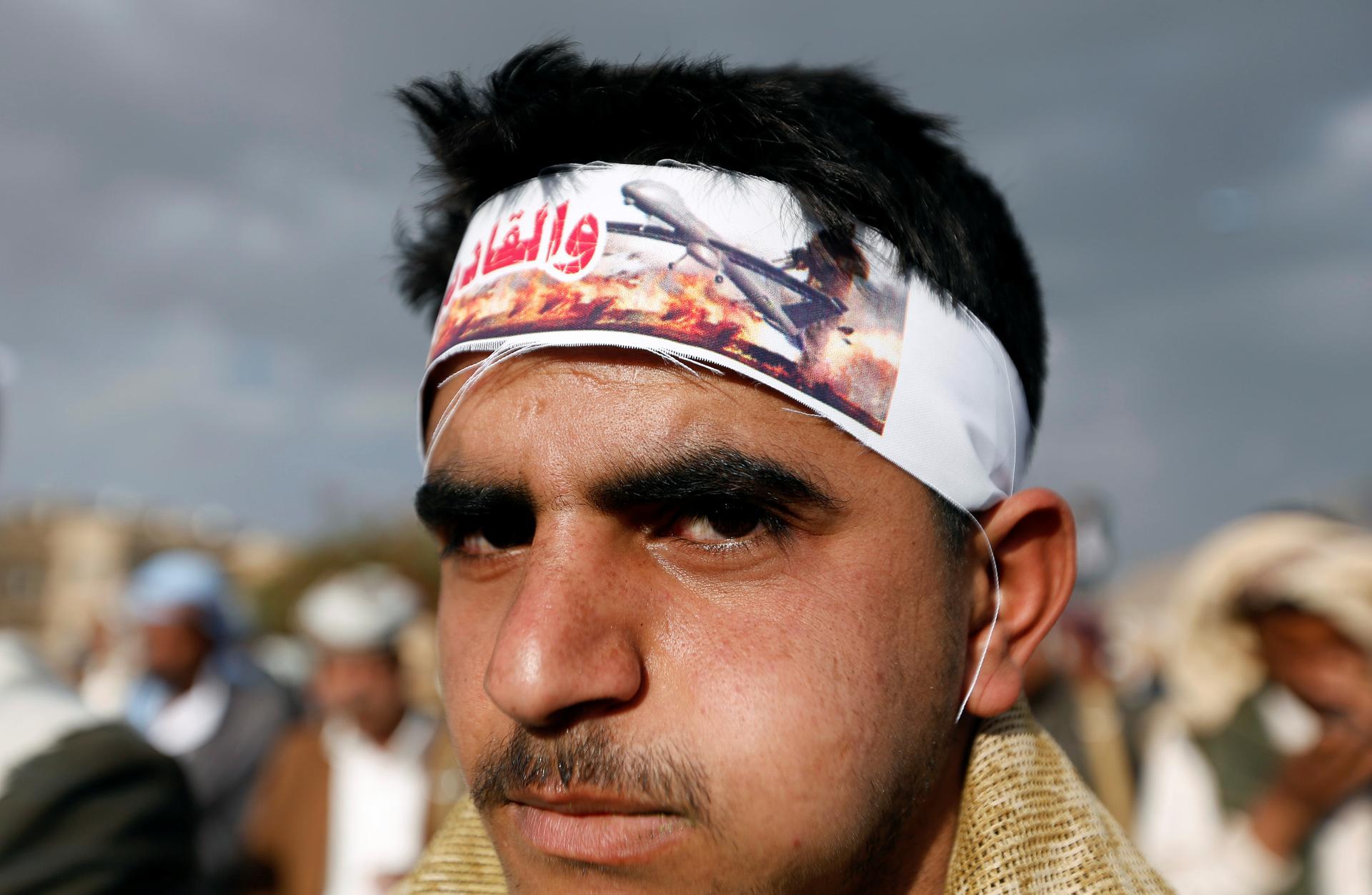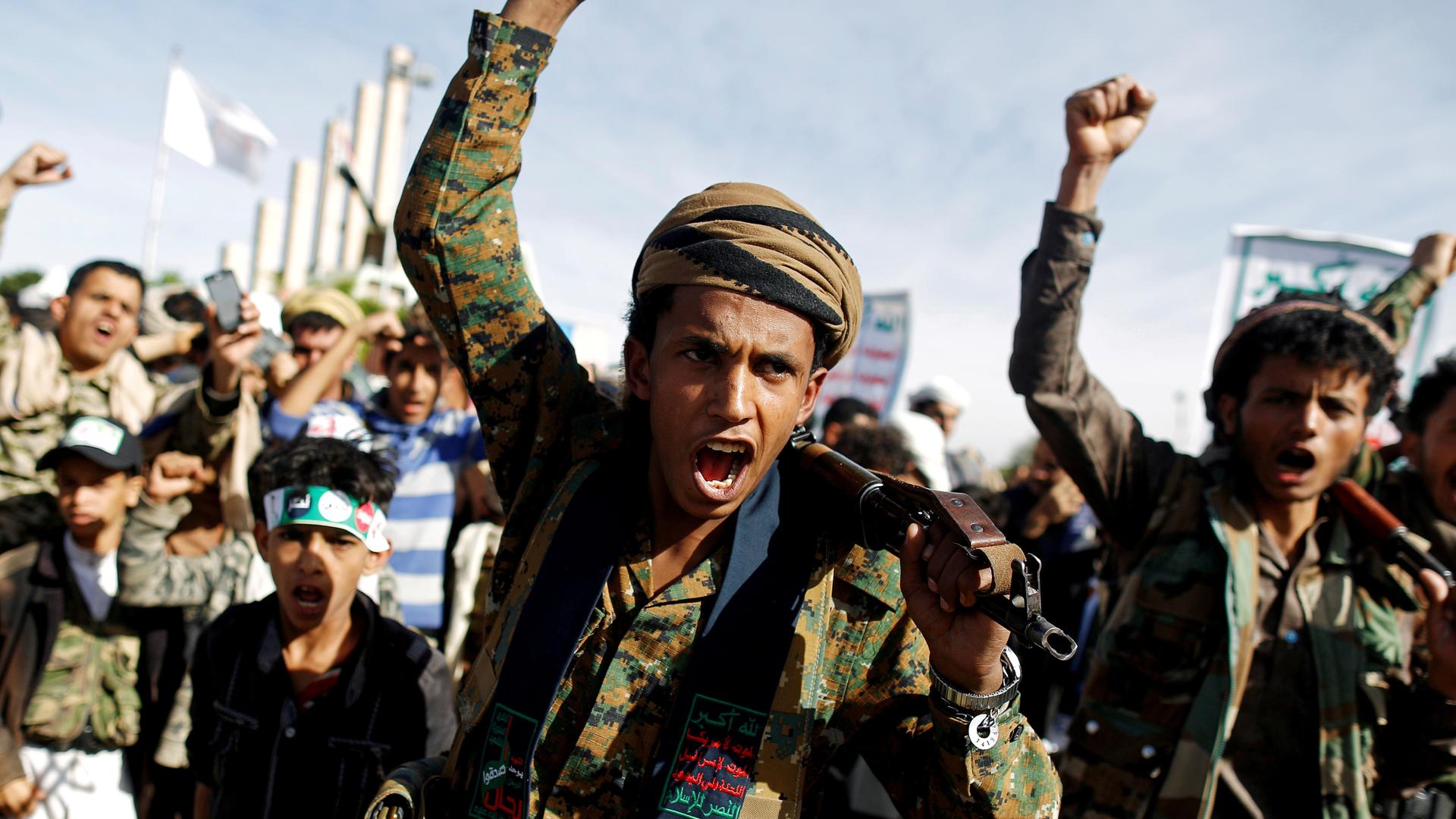Cheap drones are changing the calculus of war in Yemen
Supporters of the Houthi movement shout slogans as they attend a rally to mark the 4th anniversary of the Saudi-led military intervention in Yemen’s war, in Sanaa, Yemen, March 26, 2019.
In Yemen, civilians have grown used to the high-pitched whine of drones overhead.
This past month was no exception, with Houthi rebels repeatedly using unmanned aerial vehicles (UAVs) against the Saudi Arabia-led coalition they are fighting.
The Houthis, a tribal militia from Yemen’s mountainous north, have repeatedly stepped up their UAV campaign in their four-year war against the UN-recognized and Saudi-backed government of President Abd-Rabbu Mansour Hadi, which they view as corrupt.
Related: In Yemen, war is ‘trumping peace’
On May 23, a Houthi drone attacked a missile battery at an airport in the Saudi city of Najran, near the Yemeni border. One week prior, on May 14, Iran-aligned rebels sent seven bomb-laden drones to hit oil-pumping stations deep into Saudi, more than 500 miles from Yemen’s northern border.
All the while, their enemy, the Saudi-led coalition, continued using its larger armed, Chinese-made drones to surveil and target Houthi leaders. Last year, a coalition drone strike reportedly killed one of the Houthi group’s top politicos, Saleh al-Samad.
Related: Houthi pullback in Hodeidah comes with uptick in Yemen war
Drone use has gathered pace in Yemen since the US first unleashed one of its unmanned flying killers on al-Qaeda in 2002. Now, drones take off round-the-clock in Yemen — a sign of how rebel groups and state forces alike have embraced this technology.
But for Afrah Nasser, who left Yemen during a political crisis in 2011 and has lost family members as a result of the war and its side effects, turning Yemen into a UAV testing ground only makes a bad situation worse.
“With drones, the Houthis are showing their increased technical abilities, which are countered by more devastating responses from the Saudis.”
“With drones, the Houthis are showing their increased technical abilities, which are countered by more devastating responses from the Saudis,” Nasser, chief editor of Sanaa Review, a cultural news website, told The World.
“It’s no longer Yemen’s civil war, but a face-off involving the Gulf, the US and Iran, and it’s civilians who suffer. But for every family destroyed by coalition bombs, enemies are created from ten of their relatives, driving a cycle of violence that we are unable to solve.”

In January, a Houthi drone strike on a military parade at al-Anad air base killed and injured some of Hadi’s military and intelligence chiefs. In 2018, the rebels claimed to have launched drone attacks at airports as far away as Abu Dhabi and Dubai, in the UAE, a coalition member.
Carrying out UAV hits on such far-off targets marked a breakthrough for the Houthis, who have no air force and achieved most of their military gains in Yemen with assault rifles, missiles, off-roaders and rocket launchers.
Justin Bronk, who wrote a report on drones in the Middle East for the Royal United Services Institute, a UK military think tank, said Houthis also use drone-mounted cameras as an “eye in the sky” so that other weapons, such as mortars, are better at hitting their marks.
For the Houthis, there is no downside to using UAVs. They expose militiamen to fewer risks than conventional attacks and, according to Yemen’s Foreign Minister Khaled al-Yamani, cost as little as $45 per drone strike.
Houthis use “quadcopter” style drones or toy aircraft like those sold on Amazon and fit them with cameras and bombs wrapped in ball bearings. They can maim and kill, said Bronk, but won’t win a war any time soon.
Of course, the budget Houthi drones are not a patch on top-end UAVs, such as US-made Predators, which can travel vast distances, be piloted from thousands of miles away, hover in the sky for hours and unleash the fury of Hellfire missiles.
“The Houthis face vastly more technologically capable opponents, but if you smuggle gear in behind their border, quad drones offer a really effective way of irritating an otherwise extremely well-defended opponent.”
“The Houthis face vastly more technologically capable opponents, but if you smuggle gear in behind their border, quad drones offer a really effective way of irritating an otherwise extremely well-defended opponent,” Bronk said.
“These little commercial drones won’t cause huge problems in terms of firepower, but they’re embarrassing, they cause a news story and it tells ordinary Saudis that they’re not safe in their own country, all of which is a good, economical use of Houthi resources.”
Saudi Arabia says that arch-foe Iran has provided the Houthis with know-how, UAVs and other arms. Tehran denies this. The UN’s panel of Yemen experts has noted similarities between Houthi and Iranian drones and is investigating further.
For their part, the oil-rich Saudis and Emiratis use top-end gear, such as unarmed Predator XP drones, which are bought from the US, and Chinese-made Wing Loongs, which are deployed to surveil and assassinate Houthi leaders.
Related: Trump’s override of Congress on weapons deals ‘is exactly what Iran would want’
This month’s Houthi strike on Saudi Arabia’s East-West oil pipeline has drawn particular attention, as it puts the war in Yemen more clearly in the context of rising tensions between the US and its Gulf Arab allies, and Iran.
The Houthi UAV attack came within days of a sabotage hit on two Saudi oil tankers and other vessels that were bunkering off the coast of the United Arab Emirates as well as a rocket attack on the Green Zone in the Iraqi capital, Baghdad.

On a visit to the UAE capital Abu Dhabi on May 29, US National Security Adviser John Bolton linked the attacks and said Iran was “almost certainly” behind the tanker strike. Tehran denies any involvement.
Bolton was due to meet Arab leaders in Saudi on May 30 to brainstorm how to respond. The US is sending 1,500 troops to the region, deploying an aircraft carrier strike group and sending bombers and additional Patriot missiles.
For Wim Zwijnenburg, a drone expert for the Dutch peace group PAX, which has reported on the proliferation of cheap armed UAVs, the stakes are high, as Yemen has become the region’s “test-bed of drone warfare.”
“It’s ironic that the country where drone warfare took off in 2002 turned out to be a Pandora’s box, as we see now many types and sizes of drones being deployed in various missions.”
“It’s ironic that the country where drone warfare took off in 2002 turned out to be a Pandora’s box, as we see now many types and sizes of drones being deployed in various missions,” said Zwijnenburg, who also coordinates the European Forum on Armed Drones.
As such, drone use in Yemen has worrying implications for the turbulent Middle East.
Hi-tech military drones are currently built, deployed and exported by Israel, Turkey and Iran. Other countries — such as Saudi, the UAE, Jordan and Iraq — possess UAVs, often bought from China.
The Houthis are not the only insurgent group to get in on the game.
The Lebanese militia, Hezbollah, has used spy and attack drones against Israel since the 2000s. The Palestinian group, Hamas, ISIS, the Kurdish Peshmerga, Libyan rebels and others have used them, too.
The appetite for drones is self-evident, Zwijnenburg said. They are getting cheaper and deadlier, but monitoring of cross-border UAV sales is limited, and non-military drones are not covered by arms trade deals anyway. Civilians, it seems, could pay the price again.
“Drones have proved their worth now,” Zwijnenburg said. “In the future, it will be challenging to limit the proliferation of drones and their misuse by states and non-state actors in ways that violate international law.”
